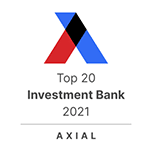
Items To Think About
When I look at the food and beverage market, I see two markets – global companies with strong brands and smaller, innovative companies targeting segments in health foods and other high growth categories. With global food and beverage companies wielding so much power, smaller players need to be smarter – strategically, operationally, financially – to succeed.
“Coca-Cola is the perfect business because it has this gigantic durable competitive advantage, or moat, which gives it predictable cash flow.”
Charlie Munger Berkshire Hathaway
Coke has spent the better part of a century building a dominant brand, but the good news is your protective barrier doesn’t have to take decades to build or involve a secret formula…it often comes from the executing the everyday parts of your business – excellence in operations, superb customer service, sound financial management, and diversifying your customer base. Executing on these basics leads to enhanced performance that will build your moat and result in an attractive valuation if you decide to exit the business in the future.
In this post we encourage you to assess your business from the outside in – how do others in your industry view you – your competitors, partners, vendors, your customers, and potential acquirers. Next month, we’ll follow up with a closer look at the internal operations supporting your position.
Influence what others see: Be a proactive storyteller
Every business has a story – a past, a present, and a future. Showcase what you have accomplished and highlight where you are going.
- Don’t keep your success a secret. Tell your story of a consistent track record of profitable growth or the depth of your management team. Spreading your story can lead to further success, new customers, better vendor relationships, and attract potential acquirers.
- Articulate your growth plan so it speaks to your audience, whether it be your partners, employees, the bank, new customers, or a potential acquirer.
What makes your story not a “me-too?” For the founder & chef behind a successful veggieburger company, her “before the bandwagon” timing and her focus on taste were critical to her success.
Developed in the early 2000s by a mom/chef as a burger alternate (not a “fake meat”), the company developed a “true veggieburger” packed with grains and vegetables. While it was healthy, the key was it tasted really good. Customers began to spread the word and their customer base expanded beyond vegetarians and vegans to a broad range of customers. The company took note, but before they lauded their success, they laid out a plan to add new flavor profiles and line up contract manufacturing. Once they were poised for growth, they spread the word of their success to potential customers.
They gained regional distribution with UNFI and regional Whole Foods stores. Regional expansion on the East coast gave way to national distribution with Whole Foods, a rollout with Kroger, and recognition from industry leaders such as Mars.
Other veggieburgers continued to hit the market, but none compared to the company’s ingredients or flavors. The owner continues to tell her story about the company that is putting “plant” back into plant-based, and the company has experienced continued success and fended off the recent surge in plant-based “meats”.
Your products and services must be great, of course. But an engaging story helps make them memorable beyond the experience. Write it down. Articulate it. Share it.
It’s a process – strengthen the story with the long game
To take the Coke example – the formula is clearly a winner but that is not the whole story of the company’s success. Coke built a dominant global company through highly successful brand advertising, increasing distribution and sales channels, diversifying into other beverage categories, and building additional multiple brands. Analyze your business and its accomplishments, then plan out a future that builds a moat around your company. Areas to consider include:
- Long-term or exclusive contracts with key customers, sales channels, or suppliers
- Patents, intellectual property, and proprietary manufacturing methods
- Innovative sales or marketing tactics that enhance your brand AND increase the switching costs for your customers
Building value in your network of suppliers, vendors, customers, and partners creates systemic resilience – a quality that can come in very handy when the world shifts without warning. A food distributor whose focus has always been on serving that network found itself drawing on that resilience when the pandemic hit in 2020.
A local health food distribution company that focused on B2C customers had a mission of providing healthy, fresh products. The business gradually grew to become a successful regional player, so the company took a logical next step and expanded into B2B distribution with an acquisition that grew their sourcing network and diversified their customers.
The strategy proved successful until the pandemic upended their business with a spike in their traditional B2C sales while the B2B business suffered. As with many businesses, the company pivoted with significant changes in delivery operations to support the B2C spike. Astute analysis of several key operating metrics helped the management team identify near term and longer-term remedies (stay tuned for Part II of this post), and within weeks, the company stabilized the B2B business, expanded the B2B margins, and improved its overall performance.
Today, the company operates with a robust customer base ranging from households to grocers to institutions – a solid base that supports long-term growth and positive impact on the food system and its participants.
Next up:
Inside the business: Having the house in order drives superior performance and positions for growth. To learn more, please contact Jim Sowers, Managing Director, at (804) 525-8541 or [email protected]














